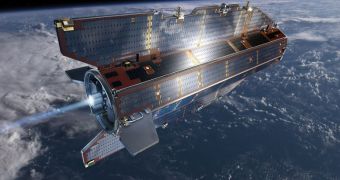Officials at the European Space Agency decided to prolong funding for the Gravity Field and Steady-State Ocean Circulation Explorer (GOCE) satellite for another 18 months, which means that the mission will not end in April 2011 as originally scheduled.
Most likely, the spacecraft will continue to fly until the end of 2012. This particular instrument has been dubbed “the most beautiful satellite ever built” due to its amazing design.
The goal of the mission is to scout otherwise-unaccessible volcanic regions, as well as to record tiny variations in the gravitational pull of our planet in several key sectors. The purpose is to understand the forces that cause the world's waters to behave the way they do.
At this point, the datasets that GOCE produces are being used by a growing number of scientific and research communities, and ESA plans to use this extension to improve the available information even further.
In addition to studying oceanic circulation, data collected by this satellite can also be used to study sea-level changes brought on by variations in the water cycle or by phenomena such as global warming, as well as processes going on inside the planet.
The ESA Earth Observation Program Board granted the new extension in recognition of the paradigm shift that GOCE produced in geosciences. Its data forced many experts to change the way they looked at gravity fields.
The satellite is also attempting to determine the geoid with an accuracy of 1-2 cm. The geoid is the true physical way in which the Earth looks like, as opposed to the idealized geometrical figure of a reference ellipsoid.
That is to say, while in reality the planet has peaks (such as Everest) and pits (like the Mariana Trench) totaling a difference of more than 19,000 meters, the geoid only records the means of these values, thus exhibiting a variation of less than 200 meters.
“Our current knowledge of the Earth's gravity is incomplete. Gravity is the force we experience daily; it keeps our feet on the ground,” said ESA GOCE program manager Danilo Muzi.
“But there is this general misconception that it is constant everywhere on the globe, which is not true. If we go to the North Pole, we will weigh more than if we are at the equator,” he added in a statement.
The gradiometers and accelerometers found aboard GOCE are the craft's main instruments, which it uses to determine slight variations in the way various regions pull on the satellite.
More mass equals more gravitational pull, experts say, and this translates into landmasses exerting more intense pulls than the oceanic crust. But GOCE looks for even smaller variations, such as the ones between close sectors of landmasses.

 14 DAY TRIAL //
14 DAY TRIAL //